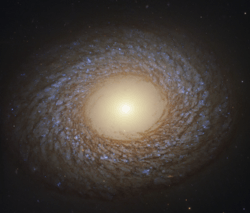NGC 2775
NGC 2775 (also known as Caldwell 48) is a spiral galaxy in the northern constellation of Cancer, located at a distance of 67 megalight-years[3] from the Milky Way. It was discovered by William Herschel in 1783. NGC 2775 belongs to the Antilia-Hydra Cloud[9] of galaxies and is the most prominent member of a small galaxy group known as NGC 2775 group, part of the Virgo Supercluster, along with the Local Group. Other members of the NGC 2775 group include NGC 2777 and UGC 4781.[10]
| NGC 2775 | |
|---|---|
 NGC 2775 as taken by Hubble Space Telescope | |
| Observation data (J2000 epoch) | |
| Constellation | Cancer |
| Right ascension | 09h 10m 20.112s[1] |
| Declination | +07° 02′ 16.53″[1] |
| Redshift | 1,316.4±13.4 km/s[2] |
| Distance | 67 Mly (20.5 Mpc)[3] |
| Apparent magnitude (V) | 10.4[4] |
| Characteristics | |
| Type | SAa[5] or SA(r)ab[6] |
| Apparent size (V) | 4′.3 × 3′.3[6] |
| Other designations | |
| UGC 4820,[7] PGC 25861,[8] Caldwell 48 | |
This object has a morphological classification of SA(r)ab,[6] which indicates an unbarred spiral galaxy (SA) with a prominent ring structure (r) and flocculent,[11] tightly-wound spiral arms (ab). The galaxy is inclined by an angle of 44° to the line of sight from the Earth.[6] The galactic nucleus is not active[2] and the large[12] nuclear bulge, which extends out to an angular radius of 0.4′,[11] is relatively gas free. An explanation for the latter could be a high supernova rate.[6] Although star formation is taking place in the dusty outer ring,[11] galaxy does not display any current starburst activity.[12]
The galaxy has a hydrogen tail feature indicates a past interaction with a faint companion.[6] A satellite galaxy appears to have orbited NGC 2775 multiple times, losing mass as it does so and creating faint, shell-like structures.[11] Nearby irregular galaxy NGC 2777 displays a tidal tail of hydrogen gas that points back to NGC 2775, suggesting the two may be linked.[13]
SN1993z is the only supernova known to have occurred in NGC 2775, which was detected September 23rd, 1993 at a magnitude of 13.9, and was classified as a Type Ia supernova.[14] By the 25th, its spectra showed that it had peaked four weeks earlier.[15]
Gallery
 NGC 2775 imaged with a 32-inch telescope.
NGC 2775 imaged with a 32-inch telescope. Map showing the location of NGC 2775.
Map showing the location of NGC 2775.
References
- Skrutskie, M. F.; et al. (February 2006). "The Two Micron All Sky Survey (2MASS)". The Astronomical Journal. 131 (2): 1163–1183. Bibcode:2006AJ....131.1163S. doi:10.1086/498708.
- van den Bosch, Remco C. E.; et al. (May 2015). "Hunting for Supermassive Black Holes in Nearby Galaxies With the Hobby-Eberly Telescope". The Astrophysical Journal Supplement Series. 218 (1): 13. arXiv:1502.00632. Bibcode:2015ApJS..218...10V. doi:10.1088/0067-0049/218/1/10. 10.
- Cappellari, Michele; et al. (May 2011). "The ATLAS3D project - I. A volume-limited sample of 260 nearby early-type galaxies: science goals and selection criteria". Monthly Notices of the Royal Astronomical Society. 413 (2): 813–836. arXiv:1012.1551. Bibcode:2011MNRAS.413..813C. doi:10.1111/j.1365-2966.2010.18174.x.
- Finlay, Warren H. (2014). Concise Catalog of Deep-sky Objects. The Patrick Moore Practical Astronomy Series (2nd ed.). Springer Science & Business Media. p. 227. ISBN 978-3-319-03169-9.
- Ann, H. B.; et al. (2015). "A Catalog of Visually Classified Galaxies in the Local (z ∼ 0.01) Universe". The Astrophysical Journal Supplement Series. 217 (2): 27–49. arXiv:1502.03545. Bibcode:2015ApJS..217...27A. doi:10.1088/0067-0049/217/2/27.
- Hogg, David E.; et al. (March 2001). "Hot and Cold Gas in Early-Type Spirals: NGC 3623, NGC 2775, and NGC 1291". The Astronomical Journal. 121 (3): 1336–1357. Bibcode:2001AJ....121.1336H. doi:10.1086/319400.
- "NGC 2775". SIMBAD. Centre de données astronomiques de Strasbourg. Retrieved 2020-04-19.
- "NASA/IPAC Extragalactic Database". Results for NGC 2775. Retrieved 2010-03-24.
- O'Meara, Stephen James; Moore, Patrick (2002). The Caldwell objects (2nd ed.). Sky Publishing Corporation. p. 192. ISBN 0521827965.
- "A List of Nearby Galaxy Groups". Atlas of the Universe. Retrieved 2010-11-28.
- König, Michael; Binnewies, Stefan (2017). The Cambridge Photographic Atlas of Galaxies. p. 35. ISBN 978-1107189485.
- Shapiro, Kristen L.; et al. (December 2003). "Observational Constraints on Disk Heating as a Function of Hubble Type". The Astronomical Journal. 126 (6): 2707–2716. arXiv:astro-ph/0308489. Bibcode:2003AJ....126.2707S. doi:10.1086/379306.
- Arp, Halton; Sulentic, Jack W. (July 1991). "The Properties of NGC 2777: Are Companion Galaxies Young?". Astrophysical Journal. 375: 569. Bibcode:1991ApJ...375..569A. doi:10.1086/170218.
- "List of Supernovae". IAU Central Bureau for Astronomical Telegrams. Retrieved 2012-01-10.
- "IAUC 5870: N Lup 1993; 1993Y; 1993Z". IAU Central Bureau for Astronomical Telegrams. Retrieved 2015-11-23.
External links
| Wikimedia Commons has media related to NGC 2775. |
- NGC 2775 on WikiSky: DSS2, SDSS, GALEX, IRAS, Hydrogen α, X-Ray, Astrophoto, Sky Map, Articles and images
- NGC 2775 at Deepskypedia